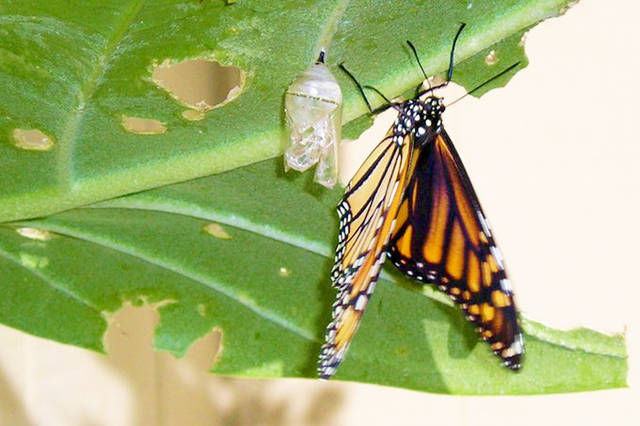Butterflies have once again emerged this past week for me in poetry and music, and dance. I’m glancing back to this weekend’s 29th annual Queen Emma Festival in Kokee, where colorful groups of hula dancers gathered to present, flitting across
Butterflies have once again emerged this past week for me in poetry and music, and dance. I’m glancing back to this weekend’s 29th annual Queen Emma Festival in Kokee, where colorful groups of hula dancers gathered to present, flitting across the meadow like butterflies. I look forward to the butterfly-themed “Of Wings and Strings,” a free concert of humorous and serious music given by the students (5 years through adult) of the Helen Sina Strings Studio on Friday, 6 p.m. at the Island School main hall in Puhi. And then, others wafting on wings of music are Kauai’s Welch family foursome, young and accomplished musicians offering varied instrumental and vocal world music numbers as a fundraiser for Lihue Christian Church, Saturday, 7 p.m., at the Lihue Parish Hall, 4340 Nawiliwili Road.
Well-known is the natural high music and dance can give you — especially tuneful and beautiful music, to lift you into the sphere transcending daily cares and worries, as if entering a “butterfly” mode. Guaranteed to be uplifting, those who attend will see what emergence is happening with our youth who put their talents and energy toward practicing and learning to make music, same as with the dance and chant with hula haumana (students) in Kokee.
On a recent stroll we admired a clump of crownflower bushes growing in a neighborhood garden which brought to mind the memory of our own crownflowers planted some years ago specifically to attract butterflies. So successfully did these members of the milkweed family do this, that they “bit the dust.” Maybe it’s time to plant more.
Why bother, since the success of their attraction led to their demise? No lei flowers, after all, after the energy expended, and a total flop as far as landscaping goes. What did we do wrong? Why did our plants make-die-dead?
Yet, maybe that was enough considering that in our experiment’s very beginning with those plants, their ending was already written. In the interweaving of life, the flora died off, but the fauna thrived and continued the cycle. Elsewhere.
Healthy clumps of untended crownflower bushes grew wild (until a roadside cleanup) along Kuhio Highway across from Kealia Beach. You could count on being able to gather ivory and pale lavender blossoms when other lei plants were scarce. Maybe our plants didn’t mature enough before they were discovered and made into butterfly nurseries. My husband reminded me of the hedge of crownflower “trees” surrounding one particular house on the way into Kapaa Town. Those plants persevered and bloomed well — until the house was sold and the hedge whacked to ground level.
By the time we walked back home, we’d gone through a whole crownflower history: how monarchs entertained us as they danced in the air; how, once they discovered our bushes, the butterfly nursery was established; how the eggs became a horde of fast- growing stripy caterpillars. My, they were hungry.
I watched daily, seeing where they’d nibbled and then, as they grew, gobbled holes in the leaves of the plants. Finally, there appeared an army of caterpillars that were demolishing their host food source. Lying in bed at night, I wasn’t sure if I was imagining or really hearing the munching of that ravenous bunch of young‘uns beneath our window. Then came the quiet as they spun themselves into their cocoons. Almost overnight, the skeletal plants appearing designer decorated, hung with amazing “jewels” bearing a shining gold streak. When our young friend Athena from down the block visited us, we showed her the chrysalises. She appeared to be thrilled to bear away the treasure of some leaves and several pupae in a clean mayonnaise jar with a punched lid. We felt wonderful sharing our own enjoyment of this miracle of nature.
Soon, the young monarchs began to emerge. They slowly came forth, black legs all bent, folded with damp orange wings — small umbrellas that sprang open. They balanced on blades of grass or shrubbery to dry, try their antennae and gain strength before taking flight. We gawked, continued to be amazed.
I was inspired to create a framed art piece incorporating the photographs I’d taken during the cycle, which is what became of our garden experiment — at least, that I know of. Many generations of “our” monarchs must have morphed and flown since then. Thanks to the Chinese scholar Chuang-tzu (369-286 B.C.), I found what I consider the perfect quote to add in calligraphy on the mat board, taking liberty with the original gender references via parentheses: “I do not know whether I was then a (wo)man dreaming I was a butterfly, or whether I am now a butterfly dreaming I am a (wo)man.”
What happened to the mayo jar pupae? Athena took her jar to school to share. We heard that she and her classmates were also, in time, witness to transformation of the imago, the unfolding of a young monarch, which they let free after it found its wings. Athena by now is readying to emerge into young adulthood and preparation for life. It is our hope that she — and all other of our talented youth — fly high and well …
•••
Dawn Fraser Kawahara, author and poet, made her home on Kauai in the 1980s. She and her husband, a retired biology teacher, live with books, music and birds in Wailua Homesteads. The writer’s books are available through Amazon and other outlets. For more information, see www.kauaiweddingsandbooks.com.


